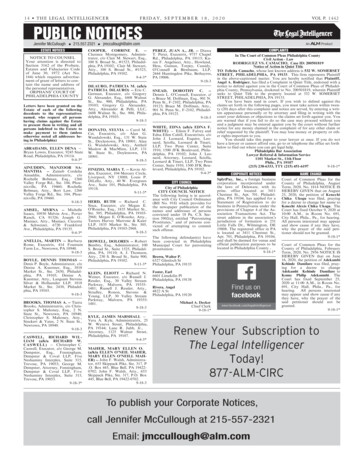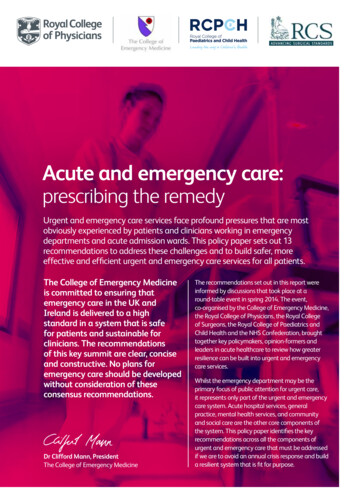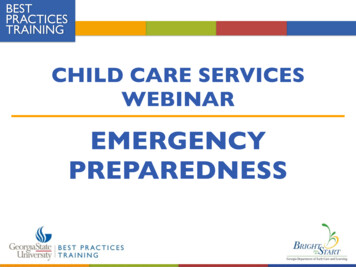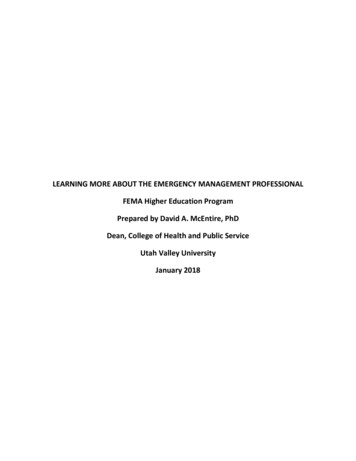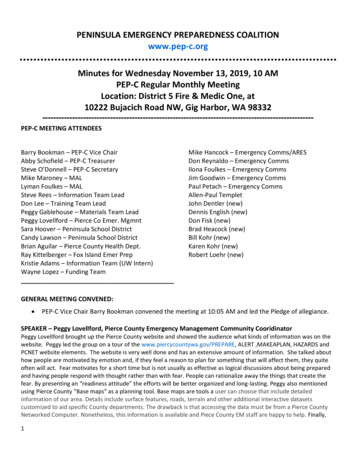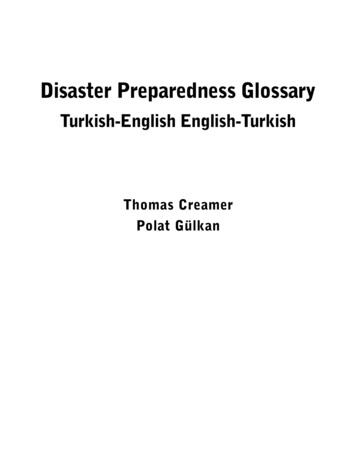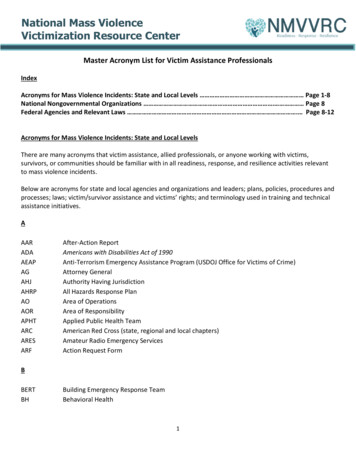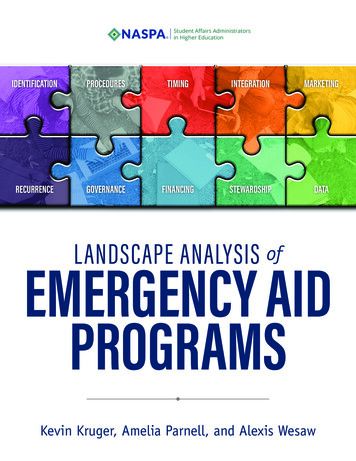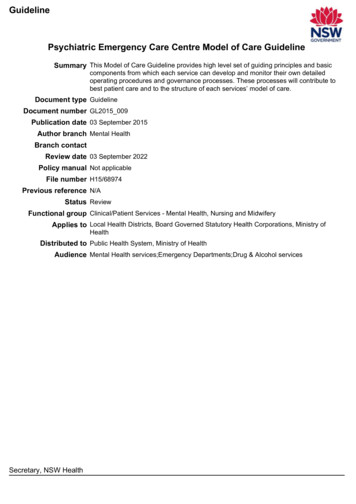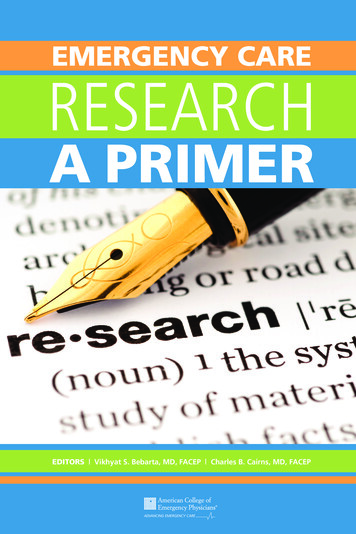
Transcription
EMERGENCY CARERESEARCHA PRIMEREDITORS Vikhyat S. Bebarta, MD, FACEP Charles B. Cairns, MD, FACEP
EMERGENCY CARE RESEARCH –A PRIMEREDITORSVikhyat S. Bebarta, MD, FACEPCharles B. Cairns, MD, FACEPSection of Emergency Medicine Researchand Research CommitteeTHIS BOOK WAS PRODUCED AS A SECTION GRANT PROJECTOF THE AMERICAN COLLEGE OF EMERGENCY PHYSICIANS.
PUBLISHER’S NOTICEThe American College of Emergency Physicians (ACEP) makes every effort to ensure that contributors to itspublications are knowledgeable subject matter experts. Readers are nevertheless advised that the statementsand opinions expressed in this publication are provided as the contributors’ recommendations at the timeof publication and should not be construed as official College policy. ACEP recognizes the complexity ofemergency medicine and makes no representation that this publication serves as an authoritative resource forthe prevention, diagnosis, treatment, or intervention for any medical condition, nor should it be the basis forthe definition of, or standard of care that should be practiced by all health care providers at any particular timeor place. To the fullest extent permitted by law, and without limitation, ACEP expressly disclaims all liability forerrors or omissions contained within this publication, and for damages of any kind or nature, arising out of use,reference to, reliance on, or performance of such information.Copyright 2012, American College of Emergency Physicians, Dallas, Texas. All rights reserved. Printed in theUnited States of America. Except as permitted under the United States Copyright Act of 1976, no part of thispublication may be reproduced or distributed in any form or by any means or stored in a database or retrievalsystem without prior written permission of the publisher.ACEP STAFFMarjorie Geist, RN, PhD, CAE, Staff LiaisonNissi George, Production Assistant
CONTRIBUTORSJill M. Baren, MD, MBE, FACEP, FAAPProfessor and Chair, Department ofEmergency MedicinePerelman School of MedicineUniversity of PennsylvaniaChief, Emergency ServicesUniversity of Pennsylvania Health SystemPhiladelphia, PennsylvaniaVikhyat S. Bebarta, MD, FACEPLieutenant Colonel, USAF, MCChief, Medical ToxicologyDepartment of Emergency MedicineSan Antonio Military Medical CenterSan Antonio, TexasKeith Borg, MD, PhD, FACEPAssistant ProfessorDivision of Emergency MedicineMedical University of South CarolinaCharleston, South CarolinaCharles B. Cairns, MD, FACEPProfessor and ChairDepartment of Emergency MedicineUniversity of North CarolinaChapel Hill, North CarolinaJudd E. Hollander, MD, FACEPProfessor, Clinical Research DirectorDepartment of Emergency MedicineUniversity of PennsylvaniaPhiladelphia, PennsylvaniaDebra Houry, MD, MPH, FACEPVice Chair for Research, EmergencyMedicineDirector, Center for Injury ControlAssociate Professor, Emergency MedicineEmory UniversityAtlanta, GeorgiaRenee Y. Hsia, MD, MSc, FACEPAssistant ProfessorDepartment of Emergency MedicineUniversity of California, San FranciscoSan Francisco, CaliforniaEdward C. Jauch, MD, MS, FACEPProfessorInterim Chief and Research DirectorDivision of Emergency MedicineProfessorDepartment of NeurosciencesAssociate Vice Chair ResearchDepartment of MedicineMedical University of South CarolinaCharleston, South CarolinaHeemun Kwok, MD, MSUniversity of Washington School ofMedicineHarbor-UCLA Medical CenterLos Angeles Biomedical Research InstituteTorrance, CaliforniaRoger J. Lewis, MD, PhD, FACEPVice Chair, Academic AffairsDepartment of Emergency MedicineHarbor-UCLA Medical CenterTorrance, CaliforniaEdward A. Panacek, MD, MPH, FACEPProfessorClinical Trials DirectorDepartment of Emergency MedicineUniversity of California, DavisDavis, CaliforniaWillard W. Sharp, MD, PhD, FACEPAssistant Professor of Medicine,Section of Emergency Medicine,Department of MedicineUniversity of ChicagoChicago, IllinoisAdam J. Singer, MD, FACEPProfessor and Vice Chair for ResearchDepartment of Emergency MedicineStony Brook UniversityStony Brook, New YorkTerry L. Vanden Hoek MD, FACEPProfessor of Emergency Medicine,Department of Emergency MedicineUniversity of Illinois at ChicagoChicago, IllinoisDonald M. Yealy, MD, FACEPChair, Department of Emergency MedicineUniversity of Pittsburgh/University ofPittsburgh PhysiciansProfessor of Emergency Medicine,Medicine, and Clinical andTranslational SciencesUniversity of Pittsburgh School of MedicinePittsburgh, PennsylvaniaJohn G. Younger, MD, MS, FACEPAssociate ProfessorAssociate Chair for ResearchDepartment of Emergency MedicineUniversity of MichiganAnn Arbor, MichiganCONTRIBUTORS — EMERGENCY CARE RESEARCH – A PRIMERI
IIEMERGENCY CARE RESEARCH – A PRIMER
TABLE OF CONTENTSPREFACE . . . . . . . . . . . . . . . . . . . . . . . . . . . . . . . . . . . . . . . . . . . . . . . . . . . . . . . . . . . . . . . . . . .VCHAPTER 1: WHAT IS ACUTE AND EMERGENCY CARE RESEARCH? . . . . . . . . . . . . . . . .1CHAPTER 2: HOW TO PICK AN EMERGENCY MEDICINE RESEARCH TOPIC . . . . . . . . . .7CHAPTER 3: WHY DO I NEED A MENTOR, AND HOW DO I FIND ONE? . . . . . . . . . . .11CHAPTER 4: KEY ISSUES IN EMERGENCY CARE RESEARCH . . . . . . . . . . . . . . . . . . .19CHAPTER 5: KEY ISSUES IN BASIC SCIENCE EMERGENCY CARE RESEARCH . . . . . .25CHAPTER 6: TRAINEES AND EMERGENCY CARE RESEARCH. . . . . . . . . . . . . . . . . . .31CHAPTER 7: PRESENTING THE RESULTS OF RESEARCH . . . . . . . . . . . . . . . . . . . . . . .37CHAPTER 8: BASICS OF SCIENTIFIC GRANT WRITING . . . . . . . . . . . . . . . . . . . . . . . .41CHAPTER 9: GETTING PUBLISHED . . . . . . . . . . . . . . . . . . . . . . . . . . . . . . . . . . . . . . .51CHAPTER 10: THE TEN COMMANDMENTS OF EMERGENCY CARE RESEARCH . . . . .59CHAPTER 11: WHERE CAN I RECEIVE MORE HELP? . . . . . . . . . . . . . . . . . . . . . . . . .65TABLE OF CONTENTS — EMERGENCY CARE RESEARCH – A PRIMERIII
IVEMERGENCY CARE RESEARCH – A PRIMER
PREFACEMany emergency medicine clinicians engaged in research may not be aware of somefundamental principles of conducting and disseminating medical research. Ignorance ofthese fundamentals can lead to investigator frustration, disorganized researcher efforts,and ultimately a reduction in the emergency care researcher pool.Conversely, an increasingly large pool of trained investigators has focused their effortstoward emergency care research. Giving these investigators an overview of the uniquechallenges and opportunities in emergency care research could be valuable, if not critical,to their success in investigations.The field of emergency medicine now has experienced and funded emergency careresearchers who can highlight key points to finding mentors, obtaining extramuralfunding, designing research proposals, initiating research, and disseminating researchresults. Some of this information has been presented in lectures, discussed at nationalmeetings, printed piecemeal in review articles, and published in lengthy books. However,a pithy, consolidated, and accessible guide focused on the junior, novice, or evolvingemergency care investigator has not been available.The American College of Emergency Physicians’ (ACEP) Emergency Medicine ResearchSection and Research Committee recognized the need for a short manual to kindle andmotivate trainees and novice investigators and to offer an introduction to emergency careresearch with a hands-on guide to initiating, completing, and disseminating research.The chapters in this manual address what constitutes emergency care research, how toidentify a research topic and find a mentor, how to address key issues in emergency careresearch, training in research, the basics of grant writing, the presentation of researchresults, getting published, the top commandments of emergency care research, andhow to start a research career.We hope that this primer serves as a resource for everyone engaged in emergencymedicine to both motivate and encourage investigators to pursue emergency care research.Vikhyat (Vik) Bebarta, MD, FACEPCo-editorCharles (Chuck) Cairns, MD, FACEPCo-editorPREFACE — EMERGENCY CARE RESEARCH – A PRIMERV
VIEMERGENCY CARE RESEARCH – A PRIMER
CHAPTER 1EMERGENCY CARE RESEARCH – A PRIMERWHAT IS ACUTE ANDEMERGENCY CARE RESEARCH?Charles B. Cairns, MD, FACEPOVERVIEW OF EMERGENCY CARE RESEARCHEmergency medicine evolved as a medical specialty from a convergence of eventsstemming from transformations in hospital systems and changing societal perceptions ofaccess to medical care. Increasing patient loads in hospitals resulted in a need for dedicatedstaffing of emergency departments (EDs). In addition, lessons from combat had highlightedthe importance of timely management of traumatic wounds and the potential for out-ofhospital care (1).The integration of these care systems and the development of resuscitation medicinelead to a remarkably expansive specialty that now delivers care to over 120 million patientsannually in the nation’s EDs and has resulted in the training and board certification of over20,000 emergency physician specialists (2).As the specialty grew rapidly, questions arose about the future of emergency medicineresearch. The Josiah Macy Jr. Foundation convened a meeting to investigate the role ofemergency medicine in the future of American medical care (1). The participants at this andsubsequent follow-up conferences (1, 2, 6, 8, 9) noted several unique factors to emergencymedicine and emergency medicine research: Emergency medical care is the only medical care resource that offers both immediacy ofcare and universality of service. Emergency medicine encompasses and interacts with all medical specialties. Emergency departments are literally the front door for the sickest and worstinjured in America. The import of immediacy of care has been proven time and again by researchperformed in the ED setting, including the very time sensitive treatments of heartattacks, stroke, shock states, pneumonia, respiratory illness, and trauma. Emergency departments function as a safety net for our health care and social systemsand are the only institutional providers mandated by federal law to treat anyone whopresents for care.CHAPTER 1 — WHAT IS ACUTE AND EMERGENCY CARE RESEARCH?1
Emergency medicine encompasses all patient populations, traverses all geographies,and interacts with every culture, race, creed, and socioeconomic class. Emergency physicians have become experts in rapid risk stratification and diagnoses. The science of short-term risk stratification, often on undifferentiated conditions withinadequate historical data, has been necessarily one of the main focuses of emergencymedicine research. The rapid and accurate diagnosis of potentially life-threatening conditions is anothernucleus of emergency medicine research and is the arena in which many newtechnologies are first studied. Research into and the administration of emergency medical services (EMS) and theresuscitation from cardiopulmonary arrest have become almost completely encompassedwithin emergency medicine.Thus, emergency medicine has a unique perspective in medical care by dealing withtime-sensitive and life-threatening disease processes across broad populations andgeographies. The clinical practice of emergency medicine encompasses a wide variety ofpopulations presenting with undifferentiated conditions and therefore providing distinctresearch opportunities. Evidence-based improvements in emergency care have been shownto improve immediate morbidity and mortality as well as affecting long-term outcomes.While there has been remarkable growth in the number of emergency care patients,emergency physicians, and emergency medicine training programs, there remain uniqueperspectives and challenges to emergency care that will require marked expansion ofresearch endeavors. Future emergency care should be guided by evidence and basedon high-quality research performed by well-trained investigators who have a realisticperspective on this challenge. Given the scope of emergency care, advances inemergency medicine research may be one of the most important areas of healthcare within the next decade.DEFINITION OF EMERGENCY CARE RESEARCHThe broad scope of emergency care is reflected in the domains of emergency care research.The emergency care patient population is diverse and includes pediatric, geriatric, medicallyunderserved, and minorities, as well as those with acute illness, exacerbation of chronicillnesses, and injuries (2). Correspondingly, emergency care research domains are broad inscope, covering broad ranges in the timing and scale of the entities being studied (Figure1-1). Thus, emergency care research spans time-sensitive emergency care as well as chroniccare, individual organ systems, regionalized health care systems, and population health.Three key aspects of emergency care research stand out (10):1. Severity — life-threatening illness and injury2. Vulnerability — all-inclusive populations, including geriatrics, pediatrics, and psychiatry3. Time sensitivity — conditions marked in time-frames of minutes to hoursThus, emergency care research may be defined as “research [that] focuses on thediscovery and application of time-critical diagnostics, decision making and treatments thatsave lives, prevent or reduce disability, and restore human health” (10).A global hypothesis for emergency care research is that “rapid diagnosis and earlyintervention in acute illness [and injury] or acutely decompensated chronic illness improvespatient outcomes” (5). Consistent with this hypothesis, there are a number of emergencycare interventions that have been shown to reduce mortality and improve outcomes forpatients with acute, time-sensitive illness or injury (Table 1-1).2CHAPTER 1 — WHAT IS ACUTE AND EMERGENCY CARE RESEARCH?
FIGURE 1-1.Examples of Emergency Care Research Domains(from the NIH Roundtable on Medical and Surgical Emergencies [2])Examples of Emergency Care Research DomainsInjuryPreventionCoronary SyndromesAcuteCareEmergent InfectionDiseases(e.g. SARS, sepsis)EmergentCareEMSMedical and Posttraumatic Resuscitation AnimalModelsDiseaseManagmentAcute versus ChronicPreventionandChronicCareSyndromes lthcareSystemsScaleTABLE 1-1.Emergency Department Interventions that Reduce Mortalityand Improve Outcomes1. Timely administration of aspirin and fibrinolytic therapy for acutemyocardial infarction2. Percutaneous coronary intervention (PCI) within 90 minutes for ST-segmentelevation myocardial infarction (STEMI)3. Appropriate empiric antibiotic administration within 4–6 hours for pneumonia4. Early goal-directed therapy (EGDT) for sepsis5. Blood pressure management for both ischemic and hemorrhagic stroke6. Therapeutic hypothermia for adults with ventricular fibrillation inducedcardiac arrest7. Administration of antibiotics for open fractures8. Administration of antidotes, such as N-acetylcysteine for acetaminophen poisoningFrom NIH Roundtable on Medical and Surgical Emergencies (2).CHAPTER 1 — WHAT IS ACUTE AND EMERGENCY CARE RESEARCH?3
IMPORTANT AREAS FOR EMERGENCY CARE RESEARCHA key characteristic of emergency care is the rapid assessment and treatment ofpotentially life-threatening illness and injury, often before a definitive diagnosis is possible.Thus, there is a need to rapidly characterize, or phenotype, emergency patients on thebasis of the severity and acuity of their disease state (2, 8).Thus, an overarching priority in emergency care research is the development and testingof modalities and strategies for the efficient and rapid identification of serious injuryand illness, often in a setting in which the clinical manifestations of the disease may besubtle or nonspecific; the disease prevalence is quite low, but the potential impact of amissed diagnosis or delay in definitive therapy is quite large (e.g., meningitis; myocardialischemia). The development of such diagnostic strategies will require new and substantiveresearch into underlying mechanisms of disease and injury, including the sequence andtiming of events after insult and injury.In addition, the development of cost-effective, rapid, and accurate diagnostic strategiesto be used in the setting of potentially serious but nonspecific patient presentations(e.g., fever in infants, shock, altered mental status, abdominal pain, chest pain, respiratorydistress) will improve health care in two distinct ways: Patients with serious illness will be more quickly and unambiguously identified,leading to more rapid initiation of effective treatment. Patients without serious illness will be more rapidly identified, minimize the need foradditional testing, reduce unnecessary and potentially harmful empiric treatment,reduce lengths of stay in the ED, and decrease unnecessary hospitalization. These lattereffects will reduce ED and hospital crowding, that currently impact the quality of andaccess to emergency care.Beyond patient characterization, there is an imperative to develop effective initialtherapeutic strategies for broad classes of patients with emergency conditions (e.g., thosewith shock, altered mental status, and respiratory distress). Furthermore, the process oftherapeutic decision making in the emergency setting of diagnostic uncertainty needs to bestudied. Equally important is the development of early therapeutic strategies for patientswith specific time-sensitive illnesses and injuries (e.g., closed head injury; myocardial,cerebral, or mesenteric ischemia; hemorrhagic shock; cardiopulmonary arrest).The development of novel diagnostic and therapeutic strategies will require new andsubstantive research into underlying mechanisms of disease and injury. In order to optimizevalue in the development of emergency therapeutic strategies, mechanistic investigationsmust pay particular attention to the sequence and timing of pathophysiological events.Furthermore, the effective translation of therapies developed in preclinical models of timesensitive disease states to the clinical research setting will require the enrollment of researchsubjects early in their clinical course when such therapies are most likely to be effective.RESEARCH AGENDAS FOR EMERGENCY CAREEmergency care research has been the subject of two important research agenda settingefforts. The Macy Foundation reports suggested these specific recommendations for thefurther evolution of emergency medicine research (1): Enhance support for basic, clinical, and health services research pertinent toemergency medicine practice. Promote collaborative and interdisciplinary research within and across traditionalinstitutional boundaries. Develop new systems to manage clinical information. Develop new methods to assess the outcomes of emergency care. Seek and develop increased funding sources for emergency medicine research.4CHAPTER 1 — WHAT IS ACUTE AND EMERGENCY CARE RESEARCH?
More recently, the Institute of Medicine Committee on the Future of Emergency Care inthe United States Health System convened and identified a crisis in emergency care in theUnited States, including a need to enhance the research base for emergency care (7). Asa result, the National Institutes of Health (NIH) formed an NIH Task Force on Research inEmergency Medicine to enhance NIH support for emergency care research. Members of theNIH Task Force and academic leaders in emergency care participated in three Roundtablediscussions to prioritize current opportunities for enhancing and conducting emergencycare research (2, 8, 9). The Roundtables were focused on: (a) neurological and psychiatricemergencies; (b) medical and surgical emergencies; and (c) emergency trauma.The objectives of these NIH Roundtables were to identify key research questions essentialto advancing the scientific underpinnings of emergency care and to discuss the barriersand best means to advance research by exploring the role of research networks andcollaboration between NIH and the emergency care community. The key themes of each ofthe three Roundtable reports are highlighted in Table 1-2.Overarching themes of the NIH Roundtable reports included (2, 8, 9): Emergency care research is characterized by focus on the timing, sequence, and timesensitivity of disease processes and treatment effects. Rapidly identifying the phenotype of patients manifesting a specific disease process,and the mechanistic reasons for heterogeneity in outcome are important challenges inemergency care research. Need to elucidate the timing, sequence, and duration of causal molecular and cellularevents involved in time-critical illnesses and injuries, and the development of treatmentscapable of halting or reversing them. Need for novel experimental models of emergency conditions. Understand regional differences in outcome for the same emergency disease processes.In addition, a number of important barriers to emergency care research were identified inthe NIH Roundtable reports (2, 8, 9), including: Limited number of trained investigators and experienced mentors in emergency care research. Limited emergency care research infrastructure and support, and regulatory hurdles.The NIH Roundtables recommended that the science of emergency care may be advancedby facilitating the following: (a) training of emergency care investigators; (b) developmentof emergency care clinical research networks; (c) emergency care–specific federal researchinitiatives; (d) involvement of emergency specialists in grant review and research advisoryprocesses; (e) support learn-phase and adaptive clinical trials; and (f) performance of researchto address unique ethical and regulatory issues in emergency research.CONCLUSIONSEmergency medicine research involves the study of time-sensitive, severe diseaseconditions that impact broad populations. The hypothesis that time makes a differencehas been proven in multiple emergency conditions. These successes have led to thedevelopment of a compelling research agenda for emergency care. Enhancement ofthe research basis for emergency care will require progress in mechanistic, translational,and clinical domains as well as collaboration of investigators across traditional clinicaland scientific disciplines. In addition, emergency care researchers will need to overcomelimitations in available infrastructure, research training, and access to emergency patientpopulations (2, 8, 9).CHAPTER 1 — WHAT IS ACUTE AND EMERGENCY CARE RESEARCH?5
REFERENCES1.Josiah Macy Jr Foundation. The role of emergency medicine in the future of American medical care.Ann Emerg Med. 1995;25:230-233.2.Kaji AH, Lewis RL, Beavers-May T, et al. Summary of NIH Medical-Surgical Emergency Research Roundtable.Ann Emerg Med. 2010;56(5):522-537.3.Aghababian RV, Barsan WG, Bickell WH, et al. Research directions in emergency medicine. Ann Emerg Med.1996;27:339-342.4.Cairns CB, Garrison HG, Hedges JR, et al: Development of new methods to assess the outcomes ofemergency care. Acad Emerg Med. 1998;5:157-161.5.Neumar RM. The Zerhouni challenge: defining the fundamental hypothesis of emergency care research.Acad Emerg Med. 2007;49:696-697.6.Courtney DM, Neumar RW, Vekatesth AK, et al. Unique characteristics of emergency care research: scope,populations, and infrastructure. Acad Emerg Med. 2009;16:990-994.7.Institute of Medicine, Committee on the Future of Emergency Care in the U.S. Health System. HospitalBased Emergency Care: At the Breaking Point. Washington, DC: National Academies Press; 2006.8.Cairns CB, Maier RV, Adeoye O, et al. NIH Roundtable on Emergency Trauma Research. Acad Emerg Med.2010;56(5):538-551.9.D’Onofrio G, Jauch E, Jagoda A, et al. NIH Roundtable on Opportunities to Advance Research on Neurologicand Psychiatric Emergencies. Acad Emerg Med. 2010;56:551-564.10. Kellerman AK: Consilience [editorial on NIH Roundtables on Emergency Care]. Acad Emerg Med.2010;56:551-564.TABLE 1-2.Key Themes from the NIH Roundtable Reports onEmergency Care Research (2, 8, 9) Emergency care research focuses on the timing, severity, and acute sensitivityof disease and treatment Rapidly identifying the phenotype and genotype of patients for a specific diseaseand mechanistic reasons for heterogenieity Elucidate the timing, sequence, and duration of causal molecular and cellularevents involved in time-critical illnesses and injuries Treatments capable of halting or reversing them Emergency care is an integrated system from emergency medical services dispatchto discharge Understand regional differences in outcome for the same disease processes6CHAPTER 1 — WHAT IS ACUTE AND EMERGENCY CARE RESEARCH?
CHAPTER 2EMERGENCY CARE RESEARCH – A PRIMERHOW TO PICK AN EMERGENCYMEDICINE RESEARCH TOPICCharles B. Cairns, MD, FACEPVikhyat S. Bebarta, MD, FACEPEdward A. Panacek, MD, MPH, FACEPIMPORTANCE OF THE RESEARCH TOPICA key challenge to having a successful research project, one suitable for publicationor grant funding, is the identification of an interesting research topic and the design ofa research approach that will be able to answer the question of interest. Many clinicallybased investigators find a research topic by examining clinical practice looking forimportant clinical challenges. Other approaches include inspiration from the clinical orscientific literature and attending conferences or lectures both within and outside ofemergency medicine.Frankly, most successful researchers have learned their topic selection and researchskills from a research mentor as part of an integrated research training program. All ofthese mentors share some combination of the attributes of curiosity, energy, innovation,scholarship, patience, and intelligence.This chapter emphasizes a practical approach to the identification of researchtopics of importance to emergency medicine researchers and to the development andcommunication of research projects competitive for publication and grant funding.BROAD RESEARCH AREAS IN EMERGENCY MEDICINEEmergency medicine is the only medical care resource that offers both immediacy anduniversality of service. Thus, emergency medicine is concerned with clinical conditions thatare time-dependent, carry high morbidity or mortality, involve diagnostic uncertainty, andaffect traditionally underserved populations (1, 2). Thus, emergency medicine researchershave a wide array of potential areas of study.CHAPTER 2 — HOW TO PICK AN EMERGENCY MEDICINE RESEARCH TOPIC7
The Macy Foundation project on the future of emergency medicine highlighted the needto develop a research agenda for emergency medicine. Follow-up projects (2, 3) suggestedthat emergency medicine research efforts be prioritized toward:1. Elucidation basic mechanisms, pathophysiology, and treatments oflife-threatening conditions.2. Perfection of techniques, modalities, and technologies to rapidly diagnose andmanage ED patients, with particular emphasis on atypical or undifferentiatedsigns and symptoms.3. Definition of the optimal role and configuration of emergency care servicesin a population-based system of care.RESEARCH DIRECTIONS IN EMERGENCY MEDICINEREPORT ON OUTCOMES RESEARCHOutcomes research was identified as a major area of need in emergency care andthere was a call for the development of new methods to assess acute care outcomes (3).In addition, the following were recommended as focus areas for outcomes studies inemergency medicine:1. Contribution of the emergency care–related services to the overall episode of care.2. Use of epidemiologically based methods to identify populations at risk foremergency events.3. Identification of disease-specific acute care outcome measures.4. New methods to assess the effect of acute interventions on quality of life.5. Measurement tools to assess the risk-adjustment of acute care patients.6. Management tools to evaluate the impact of the marginal costs of emergency medical care.7. Methods to rapidly and effectively communicate diagnostic and treatment choices topatients having acute events.The Macy Research Directions in Emergency Medicine Reports also highlighted researchfunding strategies, the value of research collaborations, developing the emergency medicineresearch infrastructure and database and informational management strategies (2–4).RESEARCH PRIORITIES IN EMERGENCY MEDICINEThe Institute of Medicine Committee on the Future of Emergency Care in the UnitedStates Health System convened and identified a crisis in emergency care in the UnitedStates, including a need to enhance the research base for emergency care (5). As a result,the National Institutes of Health (NIH) formed an NIH Task Force on Research in EmergencyMedicine to enhance NIH support for emergency care research. Members of the NIH TaskForce and academic leaders in emergency care participated in three Roundtable discussionsto prioritize current opportunities for enhancing and conducting emergency care research(6–8). The Roundtables were focused on (a) neurological and psychiatric emergencies, (b)medical and surgical emergencies, and (c) emergency trauma.The objectives of these NIH Roundtables were to identify key research questions essentialto advancing the scientific underpinnings of emergency care and to discuss the barriersand best means to advance research by exploring the role of research networks andcollaboration between NIH and the emergency care community. While the key themes andresearch priorities of the three Roundtable reports are highlighted in Chapter 1 (WhatIs Emergency Care Research?), the overarching messages of the NIH Roundtable reportsincluded (6–8):8CHAPTER 2 — HOW TO PICK AN EMERGENCY MEDICINE RESEARCH TOPIC
Emergency care research is characterized by focus on the timing, s
Associate Professor, Emergency Medicine Emory University Atlanta, Georgia Renee Y. Hsia, MD, MSc, FACEP Assistant Professor Department of Emergency Medicine University of California, San Francisco San Francisco, California Edward C. Jauch, MD, MS, FACEP Professor Interim Chief and Research Director Division of Emergency Medicine Professor
